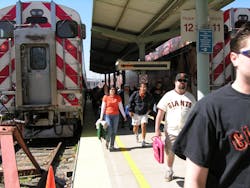New Caltrain survey shows riders plan to return
A series of recent surveys and studies show riders plan on returning to Caltrain’s service. The COVID-19 Rider Survey sought a clearer picture of how the pandemic would affect future ridership patterns.
Fifty-five percent of riders plan on riding the same or more after the pandemic, while a third of riders expect to ride less and one percent say they won’t return to the system. A breakdown of the income levels of riders show that riders that earn under $50,000 a year are the most likely to still be riding Caltrain. The returning level of ridership is in line with the findings of the polling behind a potential Caltrain revenue measure, which showed that 43 percent of all people surveyed, 68 percent of infrequent riders and 71 percent of frequent riders planned on riding as much or more than they previously had.
The Triennial Customer Survey is a comprehensive questionnaire conducted every three years, with the most recent one conducted in 2019. The survey shows the amount of riders that have access to a car has dropped from 60 percent to 51 percent. It also shows growth in the number of riders doing so to avoid traffic (72 percent, up from 62 percent in 2016) and to protect the environment (43 percent, up from 26 percent). The year of 2019 also marks the first year where people of color make up the majority of Caltrain’s ridership (52 percent, up from 47 percent in 2016). The system remains a cosmopolitan one, with 41 percent of riders being born in 107 countries other than the US.
A survey of Go Pass companies provided further insight, pointing out that 92 percent of employees at companies that participate in the Caltrain Go Pass Program are currently telecommuting, compared to 13 percent prior to the pandemic.
Caltrain says its Market Segmentation Study shows that both Caltrain riders and non-riders from all three counties view the system more favorably than Bay Area Rapid Transit, Clipper, Santa Clara Valley Transportation Authority and San Francisco Municipal Transportation Agency, as well as transportation network companies (TNCs) like Uber and Lyft. The top two recommendations by non-riders as to how to increase ridership were to improve connectivity and lower the price of riding, which the Caltrain Board is currently exploring.
